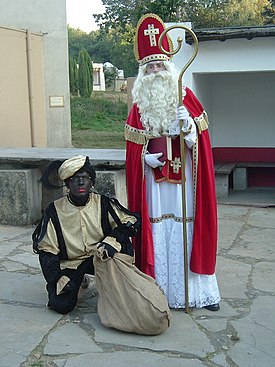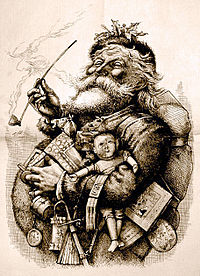This article was first printed in the Martlet (the UVic school newspaper) in about 1980. Unfortunately at this point in time, I do not know who the author is, which prevents me from giving appropriate attribution.
The present festivities of Santa Claus are very difficult to explain, because our Santa Clause is really a funny sort of bastard. No don’t get me wrong, I don’t mean a bastard in the present day context, but a bastard of the Middle Ages. He’s the offspring of old German practices going back two thousand years, and a Roman Catholic saint who lived after the reign of Constantine the Great, (4th Century A.D.) at a time when the Roman Empire was concentrated more in Constantinople than in Rome itself. Let us first look at his father, that is the old Germanic practices.
When I say Germanic I’m not quite correct because they really come from the Celtics, the ancient people who lived in present-day Britain, Ireland, and the Atlantic Coast form Holland to the Pyrennees. Now their practice was to celebrate the ‘sonnewende’ or yuletide, and this originated in the fear that the sun which stood still on that day (December 23rd) would disappear and never come back again. So to appease the sun god, they often brought human sacrifices. When the sun returned (and they knew very well it would because they’d seen it before after all), they would greet it by lighting candles, yule logs, etc., and by feting up trees. These customs remained in this form until the coming of the Irish Priest St. Boniface in 740 A.D.
 He came to the Germanic tribes which had replaced the Celts and tried to stop the pagan rituals. He found, however, that the only way he could do it was to assimilate them into Christian practices which he achieved by having the Church year begin on December 15th, and celebrating the sonnewende at the same time. Thus instead of having lights burning for the sun-god they would now be lit for the Christ child. It should be remembered that the coming of a child, especially a boy-child was a special event anyway. (Girls were not so honoured because they represented the expense of a dowry sooner or later).
He came to the Germanic tribes which had replaced the Celts and tried to stop the pagan rituals. He found, however, that the only way he could do it was to assimilate them into Christian practices which he achieved by having the Church year begin on December 15th, and celebrating the sonnewende at the same time. Thus instead of having lights burning for the sun-god they would now be lit for the Christ child. It should be remembered that the coming of a child, especially a boy-child was a special event anyway. (Girls were not so honoured because they represented the expense of a dowry sooner or later).
By the Middle Ages we see that more stress is laid on Christ’s mother, and this reflects the feeling of the time. (Nowadays we hear about women’s liberation, but in fact women were more venerated in the so-called Dark Ages then ever before. It is from this period that we get all our polite habits concerning the treatment of women). The idea of the Virgin Mary begins then as well.
All right, so now we have the yule log, the candles, the tree and the holly, but the focal point is still the crib or manger. The whole thing was designed as a joyful celebration with a serious moral intent…and that was the Middle Ages; they made everything holy, but also gave it a very human aspect as well. Now where does Saint Nicholas fit in?
Well, here we get another person who is connected with goodness and giving like the Christ-figure, and that is the Bishop of Myra whose name was Nicholas. Don’t bother looking for Myra because it doesn’t exist any more. It was once an important seaport on the Aegaan, just north of present-day Smirna; but various factors combined to reduce its place in history. However, it was once the see of a bishop and it was here that Nicholas performed the work which made him famous.
 Nicholas brought some consolation to an age which was still far from completely civilized; he was sort of a welfare officer, he helped children, did missionary work amongst sailors, and helped girls to obtain dowries; (don’t forget that this was a time when a girl without a dowry had only two other choices; prostitution or the nunnery, and the latter were not nearly so prevalent after the 3rd century). In short then, he did charity work, and since, in this period at least, it wasn’t too hard to become a saint in the Catholic church, the Pope had him canonized while he was still alive. One reason was undoubtedly because several ‘miracles’ had become ascribed to him, including the anonymous giving of money to the needy. (this was a miracle because he wasn’t likely to have had any himself let alone enough to give away). Nicholas therefore became very well known during his lifetime; but his story might not have created any lasting impression if something hadn’t happened in the 7th century.
Nicholas brought some consolation to an age which was still far from completely civilized; he was sort of a welfare officer, he helped children, did missionary work amongst sailors, and helped girls to obtain dowries; (don’t forget that this was a time when a girl without a dowry had only two other choices; prostitution or the nunnery, and the latter were not nearly so prevalent after the 3rd century). In short then, he did charity work, and since, in this period at least, it wasn’t too hard to become a saint in the Catholic church, the Pope had him canonized while he was still alive. One reason was undoubtedly because several ‘miracles’ had become ascribed to him, including the anonymous giving of money to the needy. (this was a miracle because he wasn’t likely to have had any himself let alone enough to give away). Nicholas therefore became very well known during his lifetime; but his story might not have created any lasting impression if something hadn’t happened in the 7th century.
It was then that the Muslim Arabs overran the Eastern part of the old Roman Empire and forced the Christians to retreat westward. The result was that Nicholas’ body was removed and taken to the southern Italian seaport of Bari for safekeeping. Here a large cathedral was built in his honor, and his connection with sailors grew until he was finally made their patron saint, which result that his name was spread all over western Europe.
Coincidentally, the conversion of the Slavs occurred at this time, and his name was taken by the missionaries into Eastern Europe, including Russia, where he became the patron saint of the country. (Which explains why so many Russian czars had the name Nicholas). So you can see that Nicholas was pretty well universal by this time, and all that was needed was the veneration of the practice of secret gift-giving to complete the legend.
 This occurred in the 9th century, and by the 12th century celebrating St. Nicholas Day on December the sixth was widespread all over Europe. Now actually the celebration happened on the eve of the day, December 5th, as was common for all saints festivities.
This occurred in the 9th century, and by the 12th century celebrating St. Nicholas Day on December the sixth was widespread all over Europe. Now actually the celebration happened on the eve of the day, December 5th, as was common for all saints festivities.
With the rise of the Spanish Empire in the 15th century, St. Nicholas became associated with Spain, mainly because that was where all the ‘goodies’ came from; by ‘goodies’ I mean spices and special sugar items which came from the East with the Moors. Thus the good bishop picked up a servant, a black moor who came to be called Black Peter and whose bag contained all the treasures of the Orient. Now we have all the elements of the legend together; a charitable bishop, no longer in Constantinople or Italy but in Spain, who appears on his day with his Moorish companion, all over Europe giving out delicious treats to the children. Don’t forget that sugar was a luxury, and oranges were so rare that in 1386 the city of Coventry made a special gift of twelve of them to Richard the Second. Well, to make it short, by 1300 the practice was well established all over Europe.
Now we get something else popping up and that is this: the Dutch became the main carriers of the St. Nicholas tradition simply because they became the main merchants of Europe, and most especially the Eastern spice trade. This one of the other customs which they transport is the custom of good eating.
 So now we have the two holidays of Christmas and Saint Nicholas’ Day, one with the old symbols of sonnewende, and the other with the tradition of gift-giving incorporated. What happens to them when the Dutch take them to the New World? Well, they kept them pretty much as they were, but the trouble was that the tradition of St. Nicholas had almost died out in the non Roman Catholic countries of Europe after the Reformation , simply because Protestants did not recognize holy bishops, and when ten thousand of these Puritan settlers came over to America, it swamped the small Dutch colony in New Amsterdam. Because of neglect on the part of the Mother Country, however, these settlers were very dependent on the Dutch community for the first little while, and especially on Dutch trading ships. (Don’t forget that Holland was still in control of the luxury trade, including all those items connected with the Saint Nicholas celebration).
So now we have the two holidays of Christmas and Saint Nicholas’ Day, one with the old symbols of sonnewende, and the other with the tradition of gift-giving incorporated. What happens to them when the Dutch take them to the New World? Well, they kept them pretty much as they were, but the trouble was that the tradition of St. Nicholas had almost died out in the non Roman Catholic countries of Europe after the Reformation , simply because Protestants did not recognize holy bishops, and when ten thousand of these Puritan settlers came over to America, it swamped the small Dutch colony in New Amsterdam. Because of neglect on the part of the Mother Country, however, these settlers were very dependent on the Dutch community for the first little while, and especially on Dutch trading ships. (Don’t forget that Holland was still in control of the luxury trade, including all those items connected with the Saint Nicholas celebration).
During this period, the Puritans were gradually taking over the Dutch colony, including their customs; but they had done exactly the same thing as their counterparts in Europe had done; that is to say, cut off all ties with bishops, and so taken all religious sense out of the December 5th festivity. On the other hand, the hard, sparse existence in the wilderness gave the custom of special, luxury item gift-giving a particular appeal to the immigrants, and they dearly wanted to take over the holiday, if only they could find a way of removing the association with the Catholic Church. They did it finally by removing the garment of a bishop from the Nicholas figure, (replacing the mitre with a sleeping cap for instance) and by shifting the date of the celebration to Christmas Day.
Now a curious thing happens’ the holiday, virtually forgotten in the Old World returns to Europe in its revised form and becomes popular again, and the Germans (who formed the bulk of the early settlers to New England) translate the name Saint Nicholas to the equivalent: Santa Claus. Thus it is in New England, after sixteen hundred years, that the marriage of the two great holidays takes place, and it is the Dutch, who had already married the holy idea with the profit motive, that promote the commercial aspect of the result.
 It doesn’t take much imagination to see that if you commercialize one part of it, soon the whole thing gets out of hand, especially when, like the Puritans, you have deleted the religious connotation from the patron saint. Santa Clause, no longer a bishop, could hardly be allowed to retain his origins in Catholic Spain either, so his home became the North Pole. And as for Black Peter, well! the slave trade was in full swing by this time, so the veneration of any black man had long since disappeared, and since the Eskimos weren’t known, and the Indians despised, Santa became a pretty solitary figure, with only reindeer, (substituted for the white horse he’d had in Spain), to accompany him, Mrs. Clause and the elves were the additions of a kindlier age.
It doesn’t take much imagination to see that if you commercialize one part of it, soon the whole thing gets out of hand, especially when, like the Puritans, you have deleted the religious connotation from the patron saint. Santa Clause, no longer a bishop, could hardly be allowed to retain his origins in Catholic Spain either, so his home became the North Pole. And as for Black Peter, well! the slave trade was in full swing by this time, so the veneration of any black man had long since disappeared, and since the Eskimos weren’t known, and the Indians despised, Santa became a pretty solitary figure, with only reindeer, (substituted for the white horse he’d had in Spain), to accompany him, Mrs. Clause and the elves were the additions of a kindlier age.
My family was living in Brussels, Belgium in the mid 1980’s. While there my younger sister was born on December 6. My parents did a fantastic job of adopting some celebrations and adding local cultural celebrations to our family’s traditions and we began celebrating St. Nicolas day as well as Christmas Day. The fact that we received the gift of Zoe one year was an extra bonus. As adults, we still put our shoes out on the night of December 5 in hopes that St. Nicolas and his friend black Peter (not PC at all) will give us gifts, and we always receive a potato for a few bad things we had down that year. One year in Belgium black Peter left us each a piece of coal in our shoes to represent our bad behaviour that year. Upon looking through the good stuff in our shoes, black Peter (mum and dad) announced that we would not be getting coal anymore as it was too expensive to purchase. Potatoes instead!